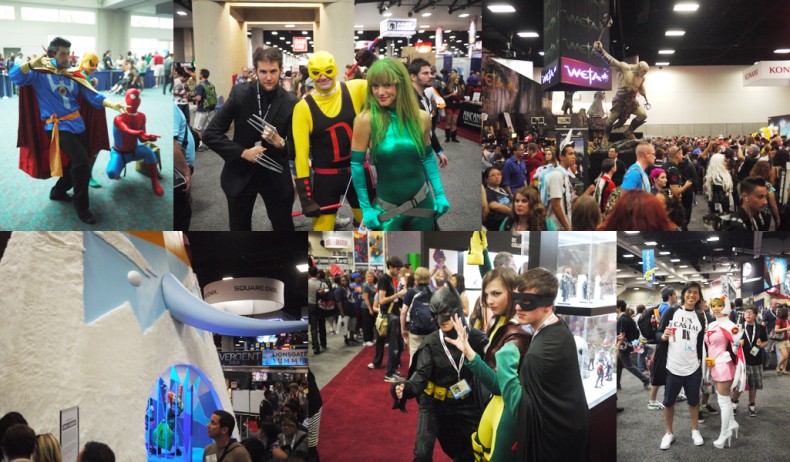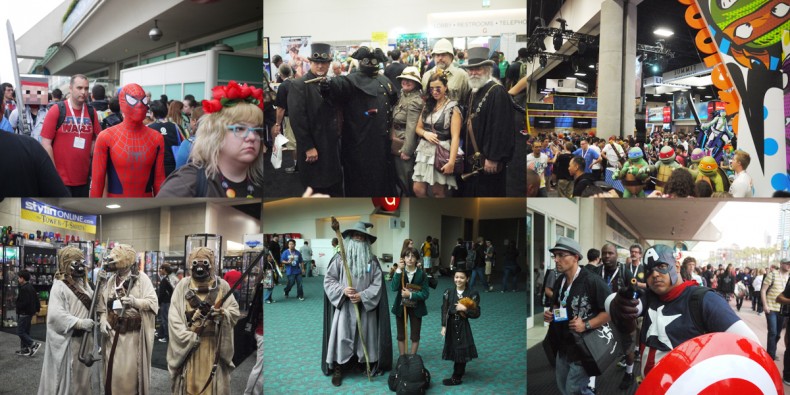Jul 23, 2013 San Diego Comic-Con 2013

It’s impossible for one person to report on the San Diego Comic-Con. There’s just too much to cover. On one end of the spectrum, up to 6,500 attendees line up and then camp out in the cavernous Hall H to drool over new trailers, exclusive clips, and hopefully some celebrities. Others comb the floor in search of original art, comics, graphic novels, pulps, action figures, robot toys, vintage lunch boxes, superhero costumes, DVDs, exclusive gear, and just about anything else a pop culture junkie might want (or sell on eBay).
Me? I’m somewhere in the middle and off to the side, and here’s my take. When I was in second grade around 1976, my circle of friends started reading Marvel comics–just in time to read key issues of New X-Men and Daredevil by John Byrne and Frank Miller, respectively. We were there for a pivotal moment when Marvel and DC began shifting their sales from 7-Elevens and magazine stands to direct-market comic book stores affording nicer paper, limited-edition covers, and higher prices aimed at collectors. Around then, I discovered independent and underground comix, which fit nicely with the punk rock that I was listening to, and moved in that direction.
The Comic-Con evolved, too. When I first went in 1979, the convention was a bunch of folding tables with boxes of comics (and comix), stacks of old books, and folios of original art. A couple of booths sold T-shirts, swords and sandals gear, and paraphernalia for role-playing game. Anime was still called Japanimation and sold in fan-subbed and duped VHS tapes. Comics were vehicles for toys, and the various brands were the ones with the largest pavilions. You’d see legends like Will Eisner and Jack Kirby hanging out poolside at the El Cortez. Since then, I’ve only missed one year and seen it grow exponentially.
These days, comics provide source materials for cinema and television. That’s nothing new or shocking since long-dying titles like Wonder Woman were just vehicles for Underoos not so long ago. But as a result, the studios have the largest presence, pouring millions of dollars into the sold-out event, flying in movie stars, throwing parties, and giving away swag. The comics artists’ buzz–not so much. But when I tell relatives and casual acquaintances that I’m going to the comic-book convention, I no longer have to explain what it is. And somehow the nerdiest thing ever has become “cool.”
Of course, there are complaints about how the convention has sold out and become bloated with Hollywood parasites looking for ideas and packed with poseurs who watch TV shows but don’t read comics. It’s become very difficult for longtime, hardcore attendees to get tickets because it sells out immediately. And the more indie, edgy, and underground vendors and artists are the ones who get squeezed out, both in terms of floorspace and dollars spent. The masses who crowd Hall H aren’t necessarily there to buy stuff; they mostly want the promotional junk, photo ops, and Instagram gold.
It’s also true that Comic-Con has become so big and so crowded that it is hard to navigate–if you are lucky enough to score tickets, secure affordable lodging, and find a decent parking space, that is.
But it’s also a golden age. Infused by anime culture, cosplay is at an all-time high.If you dig deep, you’ll find more genuine international and underground goods (and less shoddy bootlegs) than ever before. And the guests you see are out of this world. This year, I was able to survey some star-studded big-name panels (Spiderman II, Robocop, Metallica), have conversations with influential comics artists from the ’70s (Frank Brunner, William Stout), and meet current relevant artists (Paul Pope, Gene Yang). Oh yeah, I also saw a lot of friends–many at tables such as Giant Robot, Drawn & Quarterly, Grass Hut/Gargamel, Super7, Fantagraphics, Poketo–and walked away with a arms full of comics and art books. There were crowds, lines, and smelly Wookies but it was well worth it.
Really, where else can you see Star Trek enthusiasts, Star Wars fans, Hobbits, goths, anime otaku, Disney freaks, TV junkies, role-playing gamers, card collectors, toy nerds, and comics fiends all getting along in one place? (I even met Congressman John Lewis selling his first, critically acclaimed graphic novel about the civil rights movement.) I’ll see you at the Con next year–if I score one of the 130,000 tickets.



